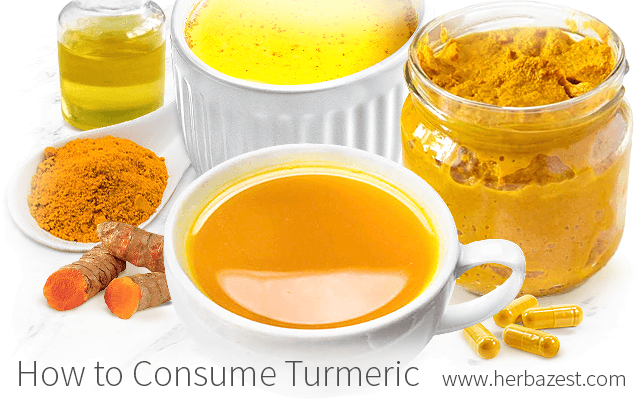Turmeric has been taken medicinally since ancient times. Over the years, as people came to realize the dietary and nutritional benefits of eating turmeric, the herb has taken on a newfound importance throughout many international markets. Nowadays, it is the subject of much speculation, including discussions on its potential medicinal properties, chemical mechanisms, and how to take turmeric for health.
How to Take Turmeric at Home
Though there are certainly ways to use other parts of the plant, the best way to consume turmeric is by using its fresh or dried rootstock in a number of different home preparations.
Turmeric with food
Although it is a main ingredient in most curry powders, you can reap the benefits of eating turmeric with a wide range of dishes, such as soups, vegetable stews, rice bowls, meat, poultry, and seafood dishes.
Fresh, raw turmeric contains aromatic notes of orange and ginger, which can enhance the flavor of various dishes. However, it should be used cautiously because of its potent curcumin content, which badly stains anything with which it comes in contact.
THE BEST WAY TO CONSUME TURMERIC IS BY COMBINING IT WITH SOURCES OF FATTY ACIDS, SUCH AS GREEK YOGURT AND COCONUT MILK, IN ORDER TO MAKE THE MOST OUT OF ITS HEALING PROPERTIES.
Ground turmeric has a much bolder taste than fresh, raw turmeric, but it loses its flavor over time.
In traditional Indian cuisine, coconut milk, cream, and butter are common additions to many turmeric-based recipes. Other ingredients that complement turmeric's flavor are onion, ginger, nutmeg, cinnamon, garlic, coriander, and cumin.
Turmeric tea
Preparing turmeric tea is perhaps one of the simplest ways to consume it. Freshly-ground turmeric can be steeped in hot water and served with honey for a warm, aromatic drink that aids digestion and pain relief.
ONE OF THE STRONGEST, MOST POWERFUL WAYS TO TAKE TURMERIC FOR HEALTH IS AS A DECOCTION MADE FROM THE BOILED ROOT ALONG WITH OTHER SPICES.
Since turmeric's active ingredient, curcumin, is fat-soluble, there is some question over whether or not turmeric's health benefits can be potentiated in an herbal tea. It is, therefore, recommended to consume turmeric tea with foods rich in healthy fats, such as omega-3 fatty acids.
Turmeric beverages
Besides tea, there are numerous other ways to take turmeric as a beverage. One of the most popular ones is turmeric golden milk, which is believed to support the immune system, prevent diabetes, and support cardiovascular health. It is made by simmering dried turmeric powder over the stovetop with warm milk, honey, cinnamon, and other flavorful, aromatic spices.
When turmeric is infused with coffee, the combination of caffeine and magnesium provides a powerful energy boost to help maintain alertness throughout the day, while antioxidant turmeric detox juices can help restore vitality to skin appearance.1
Tonics, fermented drinks - such as kombucha - and smoothies made from turmeric are also possible.
Turmeric paste
The benefits of eating turmeric paste include improving blood glucose and cholesterol levels, as well as aiding with weight management.2,3 A well-known preparation for its wide range of health benefits, turmeric paste is made by simmering turmeric powder and water over low heat until a thick consistency is reached. Often combined with a bit of coconut oil for better absorption, turmeric paste can be taken as a medicine in small doses throughout the day or added into foods and beverages.
The benefits of eating turmeric far outweigh the drawbacks. Though there is certainly a plethora of different ways to consume it, how to take turmeric for health depends on a wide range of individual needs and preferences.
Sources
- The Good Living Guide to Medicinal Tea
- The Secret Benefits of Ginger and Turmeric, pp. 84 - 85
- Turmeric: Great recipes featuring the wonder spice that fights inflammation and protects against disease
Footnotes:
- Nutrients. (2019). Potential of Curcumin in Skin Disorders. Retrieved October 7, 2021, from: https://www.ncbi.nlm.nih.gov/pmc/articles/PMC6770633/
- Nutrition Journal. (2017). Efficacy and safety of turmeric and curcumin in lowering blood lipid levels in patients with cardiovascular risk factors: a meta-analysis of randomized controlled trials. Retrieved October 7, 2021, from: https://www.ncbi.nlm.nih.gov/pmc/articles/PMC5637251/
- Frontiers in Pharmacology. (2019). The Effects of Curcumin on Weight Loss Among Patients With Metabolic Syndrome and Related Disorders: A Systematic Review and Meta-Analysis of Randomized Controlled Trials. Retrieved October 7, 2021, from: https://www.ncbi.nlm.nih.gov/pmc/articles/PMC6582779/




